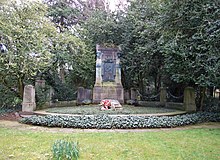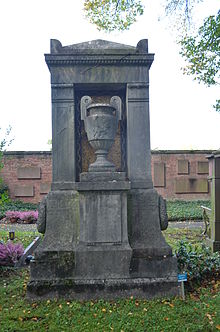Augusto Varnesi
Augusto Varnesi , also by mistake Agosto Varnesi , (born February 2, 1866 in Rome , † August 15, 1941 in Frankfurt am Main ; full name: Giulio Cesare Augusto Varnesi ) was an Italian sculptor and medalist who lived and worked in Germany from 1883 .
Life
Augusto Varnesi was born in Rome in 1866, the son of a sculptor and ore caster. At the beginning of his artistic training at the Accademia di San Luca in Rome, he became acquainted with the German sculptor Wilhelm Widemann , and in 1883 he moved with him to Munich as his student and assistant . In 1884 he followed him to Frankfurt am Main, when Widemann was appointed lecturer at the local arts and crafts school . He later did his military service in Italy , but soon returned to Germany and in 1891 went to Berlin with Widemann , where he supported him in the execution of plastic decorations in the Reichstag building .
From 1896 until his death he worked as a freelance artist in Frankfurt am Main. From 1895 he taught ornamental drawing and modeling at the Technical University of Darmstadt . In 1897 he was appointed extraordinary and in 1907 extraordinary professor appointed.
In Frankfurt am Main he created a Pietà for the Marienkrankenhaus, the group of figures “Seal” and the relief depictions “Tragedy” and “Comedy” for the new theater (1902), four larger-than-life atlases under the corridor of the new town hall (1904), which Gravestones for Lord Mayor Johannes von Miquel , the von Bethmann and de Ridder families as well as the sculptural decoration of the Matthäuskirche (1905).
Between 1904 and 1907 Varnesi executed the Golden Book of the City of Frankfurt am Main . Varnesi created the precious cover for the guest book. An ivory tablet depicting the Synod of Frankfurt in 794 is framed by finely chased gold sheets, which in turn enclose coats of arms and precious stones. For several years of work on the Golden Book, Varnesi employed several people, including the Frankfurt sculptor August Haag .
In 1926 he designed the Bridge Medal for the inauguration of the new Old Bridge , and in 1932 the Goethe Medal for the city of Frankfurt am Main. In the last years of his life, Varnesi dealt with the urban redesign of the area between the Eschenheimer Turm and Roßmarkt , which, however, did not get beyond a planning stage. On September 30, 1933, Varnesi was retired .
Augusto Varnesi was born with his wife Henriette, who died before him. Hallenstein (born September 11, 1872 - † July 9, 1938) is buried in the Frankfurt main cemetery (Gewann F 638). The tomb was designed by himself in the tradition of historicism .
Honors
- In 1911 he was awarded the Prussian Red Eagle Order IV class.
- In 1915 he became a member of the Frankfurt Freemason Lodge Zur Einigkeit .
Works
His major works, many of which fell victim to the bombs of World War II and changes in taste, include:
- Altars in the Kaiserdom St. Bartholomäus in Frankfurt and in the main church St. Michaelis in Hamburg
- Evangelist figures at the Luther Church in Worms (1912)
- Sculpture decorations of the Matthäuskirche in Frankfurt (1905; destroyed 1944)
- Group of figures poetry and the relief depictions of tragedy and comedy on the facade of the Schauspielhaus in Frankfurt (1902)
- four larger-than-life atlases under the corridor of the new town hall in Frankfurt (1904)
- Gravestones in the main cemetery in Frankfurt for Lord Mayor Johannes von Miquel (Gewann D 297) and for the families of Bethmann and de Ridder
- Binding of the Golden Book of the City of Frankfurt am Main (1904–1907)
- Plastic decoration of the stairwell and the facade of the university library in Gießen (1904; destroyed in 1944)
- Eagle relief on the Bismarck Tower in Gießen (1905–1906)
- Cosmatic work on the sarcophagi of Ludwig IV and his wife Alice of Great Britain and Ireland , the parents of Grand Duke Ernst Ludwig of Hesse and the Rhine, as well as the ravennatic-style sarcophagi of Friedrich and Maries, two siblings of the Grand Duke who died young, in the New Mausoleum completed in 1910 in the Rosenhöhe Park in Darmstadt
- Tomb for Friedrich Pützer in the Waldfriedhof Darmstadt (1922)
- Main portals in Florentine style and plastic jewelry inside the Bochum town hall, completed in 1931 (doors preserved in situ , putti from the council chamber in the town archive)
literature
- Wolfgang Klötzer (Hrsg.): Frankfurter Biographie . Personal history lexicon . Second volume. M – Z (= publications of the Frankfurt Historical Commission . Volume XIX , no. 2 ). Waldemar Kramer, Frankfurt am Main 1996, ISBN 3-7829-0459-1 , p. 501 .
- Christa Wolf, Marianne Viefhaus: Directory of professors at TH Darmstadt. Darmstadt 1977, p. 210.
- Atelier News. Augusto Varnesi. In: German Art and Decoration , 2nd year 1898/1899, 4th half volume (April to September 1899), issue 9 (from June 1899), page 431 f. ( Digitized version of Heidelberg University Library)
Web links
Individual evidence
- ↑ http://www.kunst-im-oefflichen-raum-frankfurt.de/de/page97.html
- ↑ http://www.frankfurter-hauptfriedhof.de/vanesi-f-638.htm
- ↑ Zentralblatt der Bauverwaltung , Volume 31, 1911, No. 23 (from March 18, 1911) ( online ), page 141.
- ↑ http://eople.server.de/wittur/Mausoleum/Mausoleum.html
| personal data | |
|---|---|
| SURNAME | Varnesi, Augusto |
| ALTERNATIVE NAMES | Varnesi, Giulio Cesare Augusto (full name); Varnesi, Agosto |
| BRIEF DESCRIPTION | Italian sculptor and medalist working in Germany |
| DATE OF BIRTH | February 2, 1866 |
| PLACE OF BIRTH | Rome |
| DATE OF DEATH | August 15, 1941 |
| Place of death | Frankfurt am Main |

